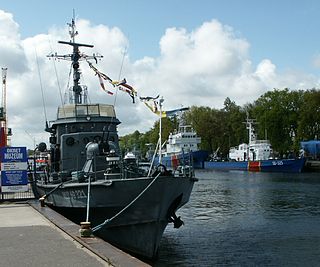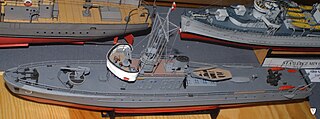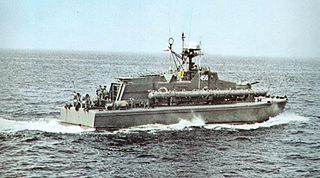
ORP Fala is a Polish patrol craft of the Project 912 class. She was the first ship of a five-ship series, commissioned in 1965. Of a Polish design, they were built in Gdynia. Fala means 'the wave'.

ORP Orkan, formerly HMS Myrmidon, was an M-class destroyer of the Polish Navy during World War II. Orkan is Polish for "hurricane".

ORP Dzik (Boar) was a U-class submarine built by Vickers-Armstrong at Barrow-in-Furness. She was laid down on 30 December 1941 as P-52 for the Royal Navy but was transferred to the Polish Navy during construction. Launched on November 11, 1942, ORP Dzik was commissioned into the Polish Navy on December 12, 1942. Her name meant "Wild Boar" in Polish.

ORP Sokół was a U-class submarine built by Vickers-Armstrong at Barrow-in-Furness. Shortly after launching in September 1940 she was to be commissioned by the Royal Navy as HMS Urchin, but instead was leased to the Polish Navy due to a lack of experienced submarine crews. A sister boat to Dzik, both boats operated in the Mediterranean from Malta, where they became known as the "Terrible Twins".

ORP Jaskółka was the lead ship of her class of minesweepers in the Polish Navy at the outset of World War II. Jaskółka was sunk during the Nazi invasion of 1939.

The Battle of Hel was a World War II engagement fought from 1 September to 2 October 1939 on the Hel Peninsula, of the Baltic Sea coast, between invading German forces and defending Polish units during the German invasion of Poland. The defense of the Hel Peninsula took place around the Hel Fortified Area, a system of Polish fortifications that had been constructed in the 1930s near the interwar border with the German Third Reich.

The Worek Plan was an operation of the Polish Navy in the first days of World War II, in which its five submarines formed a screen in order to prevent German naval forces from carrying out landings on the Polish coast, and to attack enemy ships bombarding Polish coastal fortifications, in particular the base on the Hel Peninsula.

The Project 664 class were Polish torpedo boats, designed in Poland in the 1970s. They were one of the few vessels of this size, powered by a gas turbine, and could achieve a great speed.

ORP Mazur was a torpedo boat, then gunnery training ship of the Polish Navy. She was the former German torpedo boat V-105. She took part in the Polish Defensive War and was sunk by German bombers on September 1, 1939, as the first combat ship lost in the war.
German submarine U-122 was a Type IXB U-boat of Nazi Germany's Kriegsmarine that operated during World War II.
SC 143 was a North Atlantic convoy of the SC series which ran during the battle of the Atlantic in World War II. It was the second battle in the Kriegsmarine's autumn offensive in the North Atlantic.
Nikolay Aleksandrovich Lunin was an admiral in the Soviet Navy and a Hero of the Soviet Union.

ORP Batory was a patrol boat of the Polish Border Guard which operated from the 1930s into the 1950s.
German submarine U-606 was a Type VIIC U-boat built for Nazi Germany's Kriegsmarine for service during World War II. She was laid down on 12 March 1941 by Blohm & Voss, Hamburg as yard number 582, launched on 27 November 1941 and commissioned on 22 January 1942 under Oberleutnant zur See Hans Klatt.

O 13 was an O 12-class submarine of the Royal Netherlands Navy that saw service during World War II. She was built by the Koninklijke Maatschappij De Schelde of Vlissingen. She was one of many Dutch ships doing convoy duty during the Spanish Civil War. At the time of the German invasion of the Netherlands, O 13 was on patrol off the Dutch coast and was attacked by German planes on multiple occasions. After fleeing to England, the submarine was lost during a patrol on the North Sea.
German submarine U-988 was a Type VIIC U-boat built for Nazi Germany's Kriegsmarine for service during World War II. She was laid down on 2 October 1942 by Blohm & Voss, Hamburg as yard number 188, launched on 3 June 1943 and commissioned on 15 July 1943 under Oberleutnant zur See Erich Dobberstein.

Bolesław Romanowski was a submarine commander of the Polish Navy during World War II.

Borys Karnicki was a submarine commander of the Polish Navy during World War II.

Jerzy Karol Koziołkowski was a submarine commander of the Polish Navy during World War II.
Bogusław Dionizy Krawczyk was a submarine commander of the Polish Navy during World War II.













